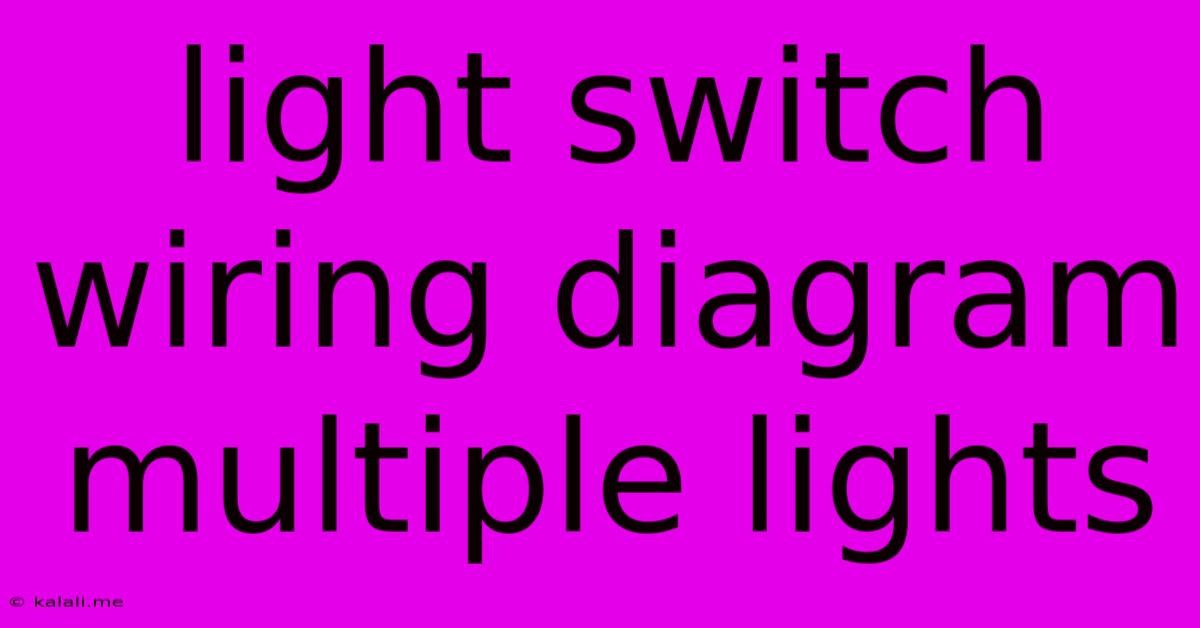Light Switch Wiring Diagram Multiple Lights
Kalali
Jun 05, 2025 · 4 min read

Table of Contents
Wiring Multiple Lights to One Switch: A Comprehensive Guide
This guide will walk you through the process of wiring multiple lights to a single light switch, covering various scenarios and safety precautions. Understanding basic electrical wiring is crucial for this task; if you're uncomfortable working with electricity, always consult a qualified electrician. This article will help you understand the process, but it's not a substitute for professional expertise.
Understanding the Basics: Series vs. Parallel Wiring
When wiring multiple lights to one switch, you'll use parallel wiring. This means each light receives its own, independent connection from the power source, ensuring that if one light fails, the others remain functional. This differs from series wiring, where lights are connected end-to-end, and a failure in one light will affect the entire circuit. For home lighting, parallel wiring is the standard and safest method.
Materials You'll Need:
- Electrical wire: Ensure you use wire appropriate for your circuit's amperage. Common types include 14/2 (14-gauge wire with two conductors) and 12/2 (12-gauge wire with two conductors). 12-gauge is generally recommended for higher-wattage lighting setups.
- Junction box: To safely connect the wires. Ensure it's appropriately sized for the number of wires you'll be connecting.
- Light switches: A single-pole switch will suffice for most setups.
- Electrical tape: For securely insulating wire connections.
- Wire strippers/cutters: To prepare the wire ends for connections.
- Screwdrivers: For tightening screws on the switch and junction box.
- Voltage tester: Essential for verifying power is off before starting any work.
Wiring Diagrams and Steps:
The simplest scenario involves wiring two lights to a single switch. Here's a breakdown:
Scenario 1: Two Lights Controlled by One Switch
- Turn off the power: This is the most crucial step. Always verify power is off at the breaker box using a voltage tester.
- Install the junction box: Position the junction box strategically to allow easy access to the wires.
- Connect the wires: In your junction box, connect the hot wires (usually black) from each light fixture together. Next, connect the neutral wires (usually white) from each light together.
- Connect to the switch: Run a cable from the switch to the junction box. Connect the hot wire from the switch to the combined hot wires of the lights, and connect the neutral wire from the switch to the combined neutral wires of the lights. The ground wires (usually bare copper or green) should also be connected together and to the junction box.
- Connect the power: Connect the incoming hot and neutral wires from your power source to the junction box. These will be connected separately to the wires running to the lights and the switch.
- Turn on the power: After double-checking all connections, turn the power back on at the breaker box. Test the lights by turning the switch on and off.
Scenario 2: More Than Two Lights (Expansion)
Adding more lights follows the same parallel wiring principle. Simply connect the hot and neutral wires of each additional light fixture to the respective bundled wires in the junction box. Ensure your junction box is large enough to accommodate all the wires. Always maintain neat and organized wiring within the box.
Troubleshooting:
- Lights not working: Check all connections for loose wires or incorrect wiring. Verify power is reaching the junction box.
- One light not working: This usually indicates a problem with that specific light fixture's wiring or the fixture itself. Check its connections individually.
Safety Precautions:
- Always turn off the power: This cannot be stressed enough. Failing to do so can result in serious injury or death.
- Use appropriate tools: Using incorrect tools can damage wires and create hazards.
- Work in a safe environment: Ensure adequate lighting and a stable workspace.
- If unsure, call an electrician: Do not hesitate to seek professional help if you are uncomfortable with any part of the process.
This detailed guide provides a foundation for wiring multiple lights to a single switch. Remember, safety is paramount, and if you have any doubts, professional help is always the best option. This information is for educational purposes and should not be considered professional electrical advice.
Latest Posts
Latest Posts
-
Territorial Behavior In Humans An Analysis Of The Concept
Jun 06, 2025
-
Its Right Behind Me Isnt It
Jun 06, 2025
-
How Many Ounces Is In A Box Of Powdered Sugar
Jun 06, 2025
-
Should You Use We Ll Keeo Or Will Keep
Jun 06, 2025
-
How To Turn Off Calls On Iphone
Jun 06, 2025
Related Post
Thank you for visiting our website which covers about Light Switch Wiring Diagram Multiple Lights . We hope the information provided has been useful to you. Feel free to contact us if you have any questions or need further assistance. See you next time and don't miss to bookmark.